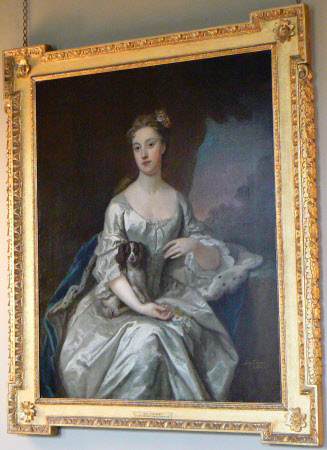Frances Worsley, Baroness Carteret (1694-1743)
Sir Godfrey Kneller (Lübeck 1646 - London 1723)
Category
Art / Oil paintings
Date
1715
Materials
Oil on canvas
Measurements
1540 x 1297 x 50 mm
Place of origin
England
Order this imageCollection
Ham House, Surrey
NT 1139785
Summary
Oil painting on canvas, Frances Worsley, Baroness Carteret (1694-1743) by Sir Godfrey Kneller (Lübeck 1646/9 - London 1723). 1715. Inscribed, lower right: Lady Carteret / T.Hudson. A three-quarter-length portrait of a young woman, seated, gazing at the spectator, with a spaniel on her lap under her right arm, her left arm resting on a stone ledge, her dark brown hair is dressed up with flowers, and she is wearing a white silk low cut dress and a blue ermine line cloak has fallen from her shoulders. A cave or bower on the left, and a distant view of trees and a cloudy sky on the right.
Full description
The sitter was the daughter of Sir Robert Worsley, 4th Bt. and the Hon. Frances Thynne, Lady Worsley. She married John Carteret, Viscount Carteret, afterwards Earl Granville (1690-1763) in 1710. She was the mother of Lady Grace Carteret (1713-55), the wife of Lionel Tollemache, 4th Earl of Dysart (1708-70). The portrait’s softer and paler colouration dates the portrait to Kneller’s style of the 1710s, compared to his baroque older work, when his influence was greatest. He was the Governor of the first Academy in London (1711–1718) and was granted a baronetcy by King George I in 1715, the same year this portrait was made. Having her portrait made by Kneller at this time highlights Frances’s focus on social image and fashion. Frances was on speaking terms with Caroline, the Princess of Wales and, in one account, Frances’s fashion sense was acknowledged when the Princess ‘admired my Lady Carteret’s [dress] extremely.’ Inspired by Caroline’s social custom of holding drawing rooms, Frances introduced the custom to Dublin Castle when she was Vicereine of Ireland (1724-1730). By imitating the Hanoverian Court, Frances promoted a modern image of herself and raised the social standing of the Irish vice-regal court.
Provenance
Probably bequeathed to the sitter's daughter, Grace Carteret, 4th Countess of Dysart (1713-55), thence by descent, (in William Lord Huntingtower's 1844 catalogue); until acquired in 1948 by HM Government when Sir Lyonel, 4th Bt (1854 – 1952) and Sir Cecil Tollemache, 5th Bt (1886 – 1969) presented Ham House to the National Trust, and entrusted to the care of the Victoria & Albert Museum, until 1990, when returned to the care of the National Trust, and to which ownership was transferred in 2002
Makers and roles
Sir Godfrey Kneller (Lübeck 1646 - London 1723), artist previously catalogued as attributed to Thomas Hudson (Devonshire 1701 – Twickenham 1779), artist
Exhibition history
Vicereines of Ireland: Portraits of Forgotten Women, Dublin Castle, Ireland, 2021
References
Campbell 2021: Myles Campbell (ed.), Vicereines of Ireland: Portraits of Forgotten Women (exh. cat.), Dublin Castle, 15 August 2021 - 5 September 2021, pp. 230-231, no.6

